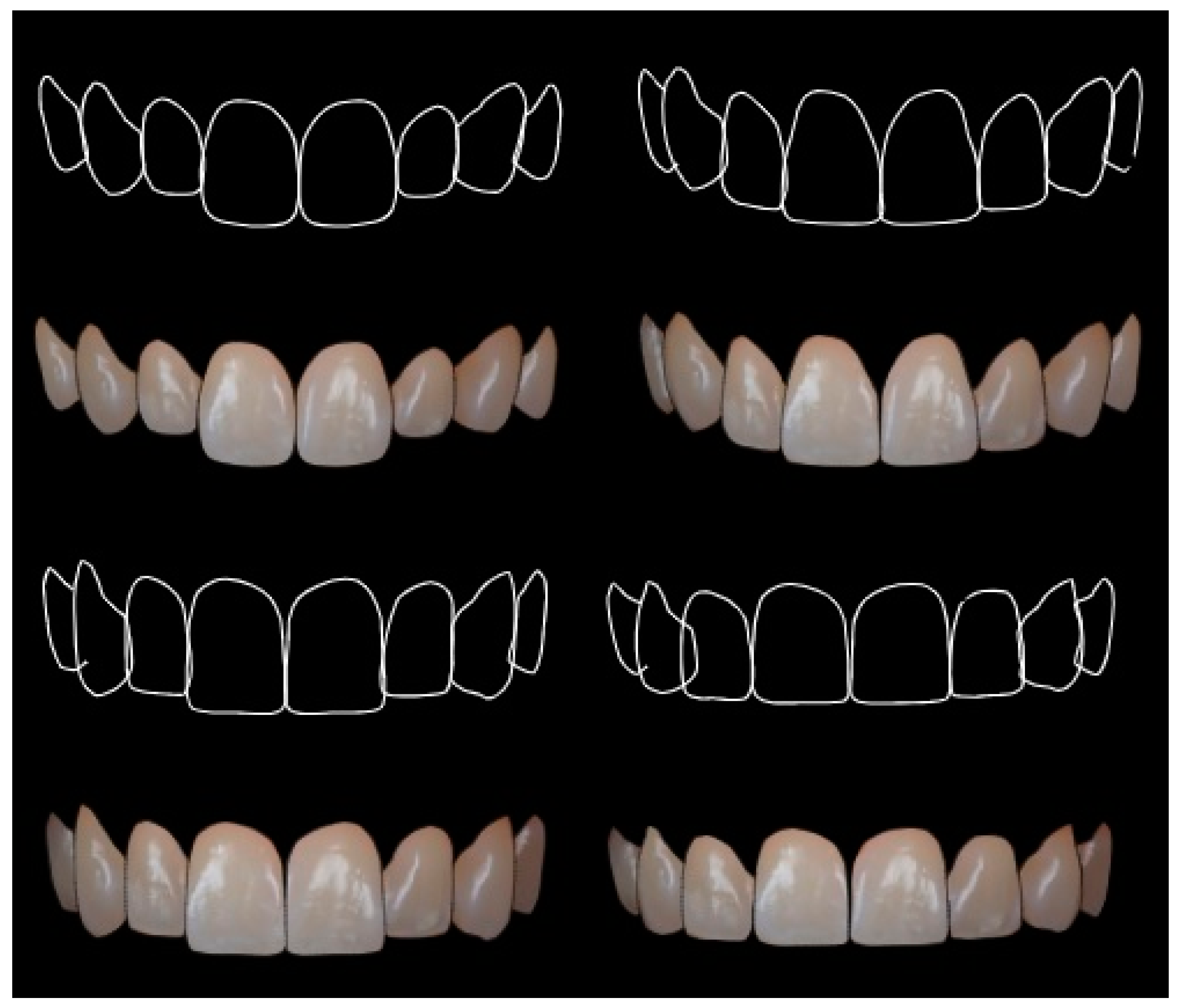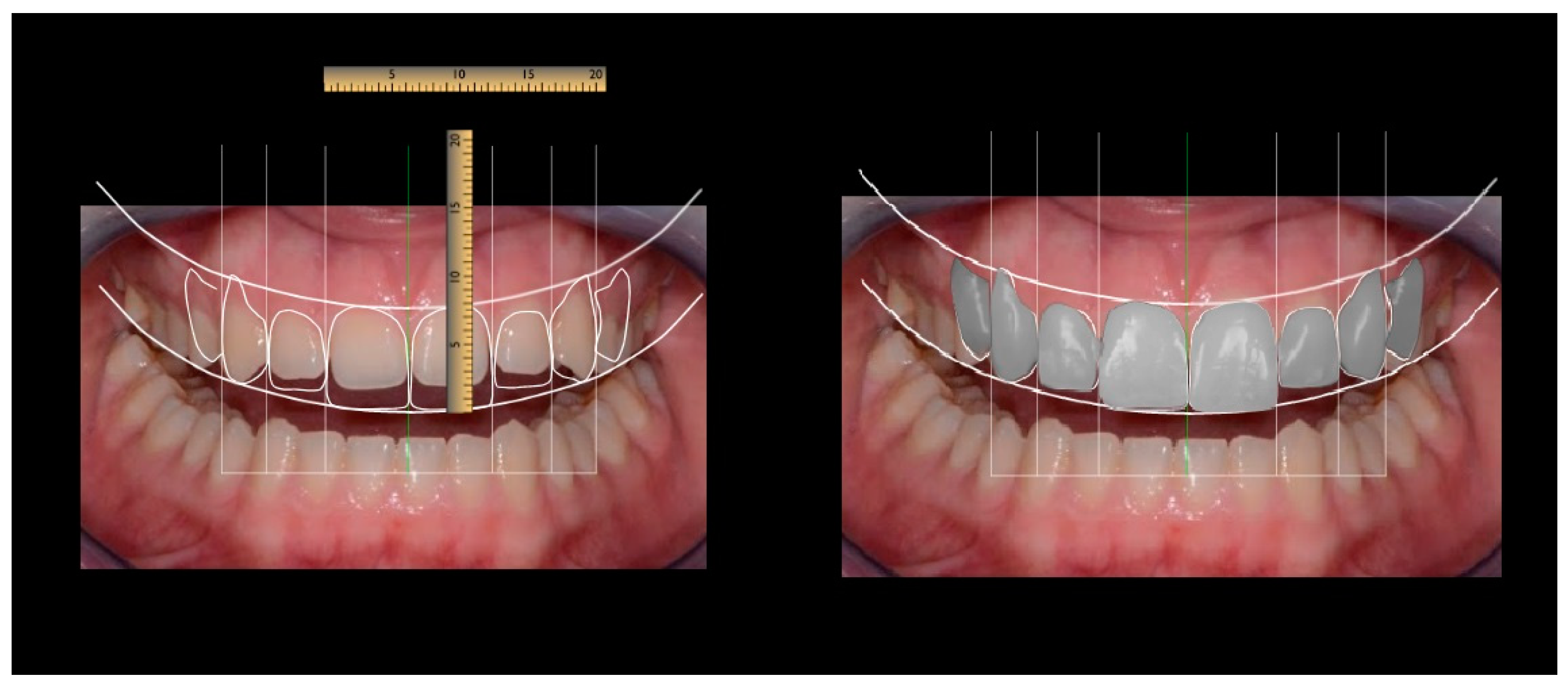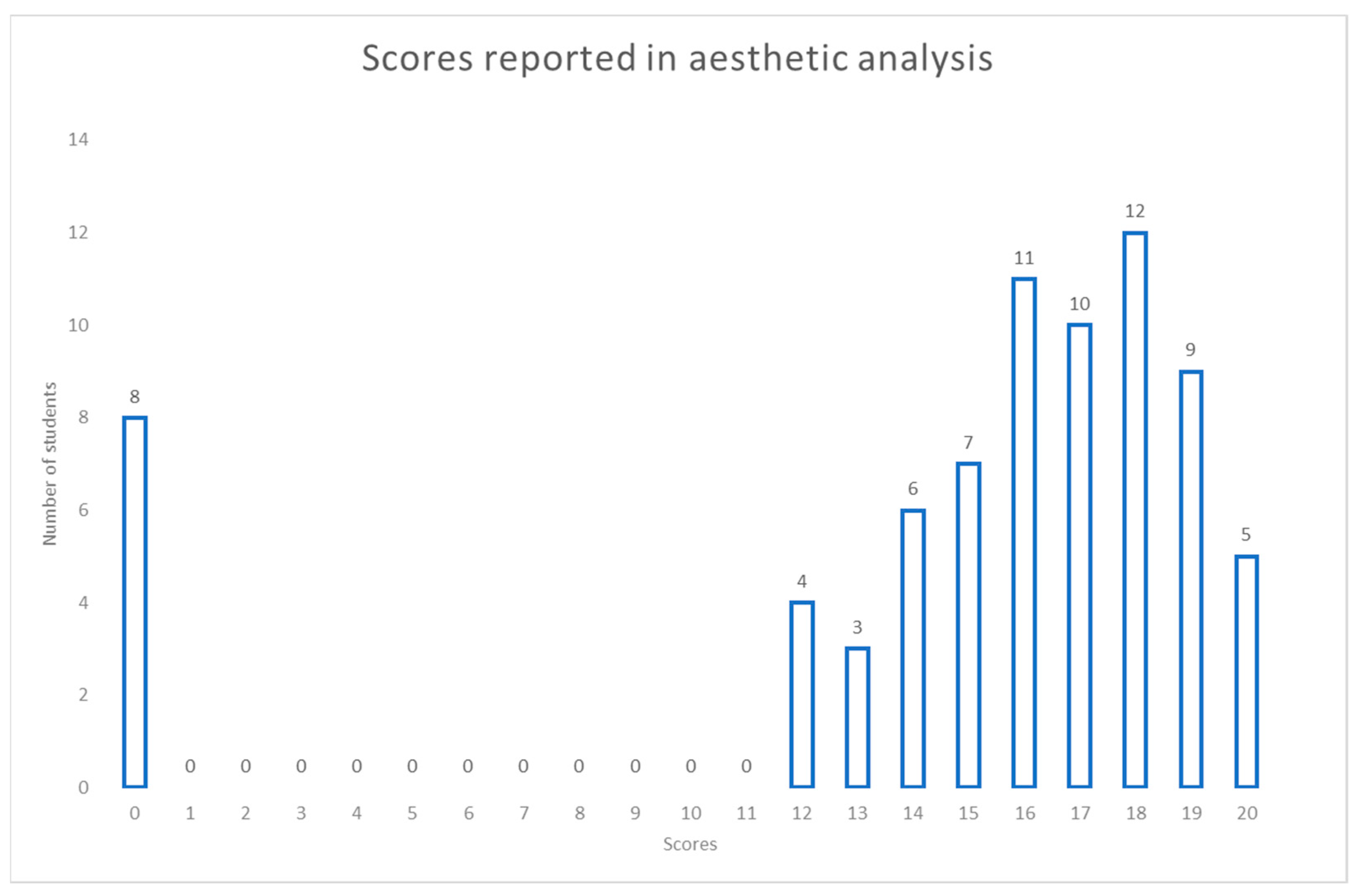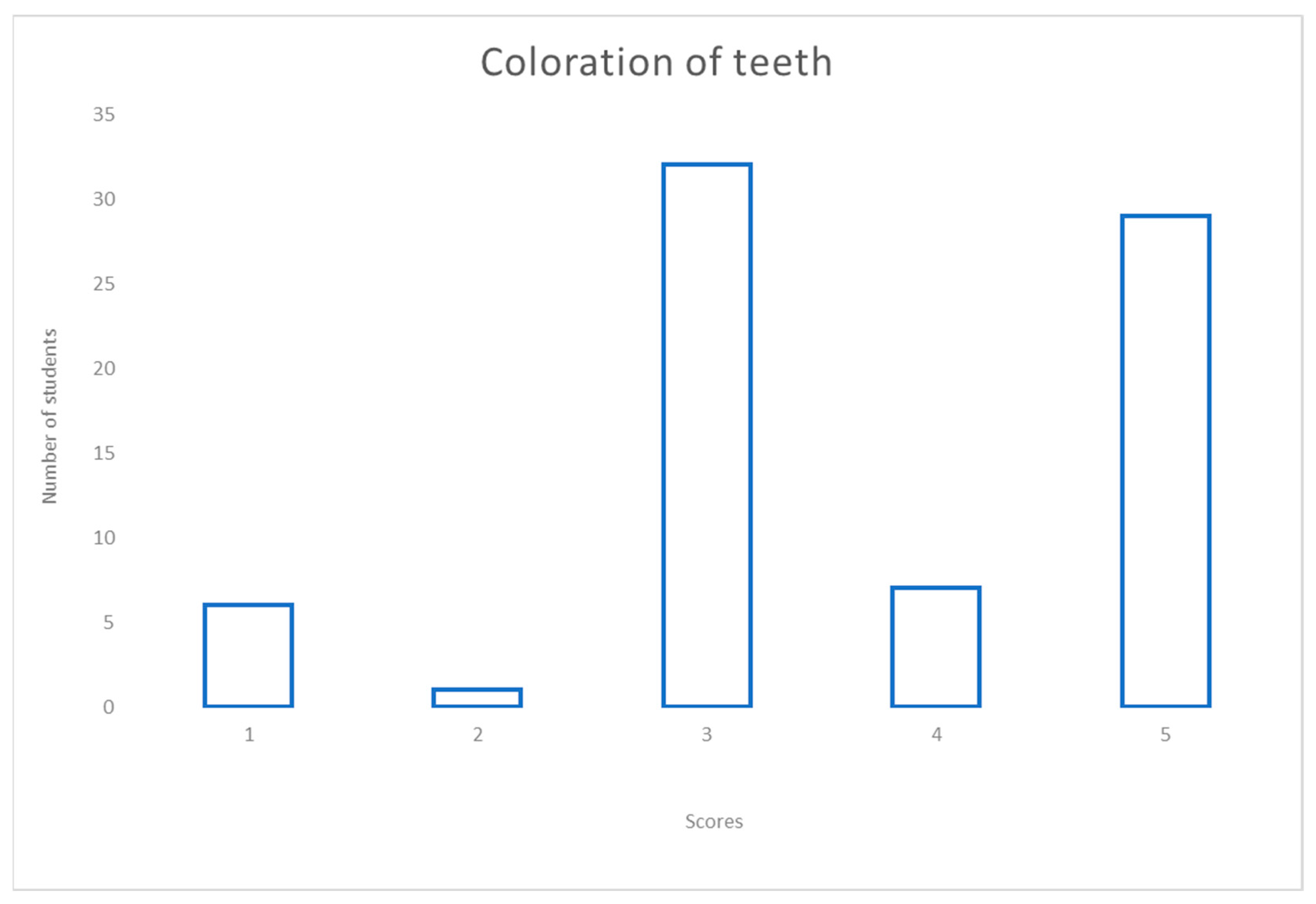Proposal for Introducing a Digital Aesthetic Dentistry Course in Undergraduate Program: Contents and Ways of Administration
Abstract
:1. Introduction
- To set up a digital course in aesthetic dentistry using open-source software at the University of Verona;
- To evaluate the effectiveness of two different teaching methods of digital aesthetic planning (traditional slides and video tutorials).
2. Materials and Methods
2.1. Design of Digital Aesthetic Dentistry Course
- Elements of digital photography in dentistry, setting, and photographic techniques for intraoral and extraoral images (theoretical course);
- Elements of digital aesthetic analysis according to the latest findings from the literature;
- Elements of digital creation of an aesthetic dental rehabilitation (upper frontal sector) using the two most popular software: Microsoft PowerPoint (Microsoft Office, Microsoft, Redmond, WA, USA) and Keynote (iWork, Apple, Cupertino, CA, USA).
- The outcomes of the course were set as follows:
- Students will be able to create and take intraoral and extraoral photographs for digital aesthetic analysis;
- Students will recognise the main aesthetic parameters and landmarks from the current literature and apply them to their own digital aesthetic analyses;
- Students will be able to use Power Point (Microsoft Office, Microsoft, Redmond, WA, USA) and Keynote (iWork, Apple, Cupertino, CA, USA) software to create an aesthetic digital dental restoration of the upper social six sector based on the aesthetic parameters taught in the course
- Group 1: Teaching with slides: frequently used slides with information and knowledge to learn the theoretical basics of the course. In addition, the technical-practical steps to implement the ability to create a digital aesthetic rehabilitation were taught on the same slides. The presentation, with its many pictures, diagrams, and charts, was designed to help students understand all the topics covered in the course. No animations of figures were included. The duration of the lesson was 90 min.
- Group 2: Video tutorial lessons: For simplicity, 3 different videos were created for the three topics of the course: ‘Digital Dental Photography’, ‘Digital Aesthetic Analysis’, and ‘Digital Smile Creation’, each lasting about 30 min. Slides were integrated and edited into the video to explain the purely theoretical parts, and animated video sequences were used to show and clarify the practical procedures of the different steps of each topic. Setting up the camera to take intra-oral and extra-oral photos, measuring aesthetic parameters and determining useful lines and landmarks for analysis, overlaying images and templates, and using software tools and menus to perform the required steps for both Power Point and Keynote were shown in video sequences. The video tutorials guided the students step by step through the different topics and towards the realisation of the digital project. The narrator of all the videos was the lecturer of the course, the same person who teaches the traditional classes with slides and does the aesthetic analysis and digital dental restoration.
2.2. Assessment of the Outcomes of the Course
- A file of slides for the students who participated in the class with slides and 3 video tutorials for the students who participated in the class with video tutorials. For all students there was a set of intra-oral and extra-oral photographs to perform exercises; two template files with the same content were loaded in the folder, one for PowerPoint and the other for Keynote. The choice between the two files and the software did not affect the execution processes, so no differences were made in the evaluation phase;
- a final survey that students were required to answer after completing the exercise, which was used to gauge their level of agreement with the course they had completed (Appendix A);
- a pdf file with instructions on how to properly conduct the exercise and resubmit the assignment for grading (Appendix B).
- Aesthetic analysis: using the photographs of the patient and the diagrams provided in the template, the students performed the aesthetic analysis of the subject by selecting the features of the patient that they thought were correct on the “Module of Aesthetic Analysis of the Patient” (Figure 1).
- Digital Smile Creation (DSC): on the same photos, the student had to carry out the digital project using the material and explanations received during the class. In this process, he chose among the suitable tooth shapes (Figure 2), positioned the new tooth elements (templates) on the previous ones and coloured them with one of the explained modes (Figure 3). Once the digital project was completed, the student was asked to take a screenshot of the finished project as proof that the exercise had been performed.
2.3. Aesthetic Analysis
- 2 points: correct answers on lip line, gingival parabolas, smile line, dental midline;
- 1 point for correct answers to all other parameters.
- less than 5 min (score 1);
- between 6 and 10 min (score 2);
- between 11 and 15 min (score 3);
- between 16 and 20 min (score 4);
- more than 20 min (score 5).
2.4. Digital Smile Creation
- Execution time, measured in minutes: For simplicity, time intervals were created and a score was given from 1 to 7: less than 5 min (score 1), between 6 and 10 min (score 2), between 11 and 15 min (score 3), between 16 and 20 min (score 4), between 21 and 25 min (score 5), between 26 and 30 min (score 6), and more than 30 min (score 7; between 6 and 10 min (score 2);
- Positioning of the teeth measured with the distance in mm from the midline of the face (determined by the expert), which was considered to be a value of 0. Shifting of the elements to the left was considered with negative values and shifting to the right with positive values; measurement was done on the photo with a digital calliper;
- Shape of the teeth (the students were provided with three different templates with different tooth shapes, which could be changed in width and length);
- Size and symmetry of the teeth, scored from 1 to 5 based on the gold standard set by the teacher (Table 1);
- Colour of the teeth
2.5. Statistical Analysis
- Differences in the time taken to complete the digital aesthetic analysis between the two groups;
- Comparison between the two groups in terms of knowledge of the 4 selected parameters (lip line, gingival charts, smile line, dental median).
2.6. Final Survey
3. Results
3.1. Aesthetic Analysis
3.2. Digital Smile Design
3.2.1. Execution Time
3.2.2. Positioning of Teeth
3.2.3. Shape of Teeth
3.2.4. Size and Symmetry of Teeth Positioned
3.2.5. Coloration of Teeth
3.3. Final Survey
4. Discussion
5. Conclusions
Author Contributions
Funding
Institutional Review Board Statement
Informed Consent Statement
Data Availability Statement
Acknowledgments
Conflicts of Interest
Appendix A. “Appreciation of Teaching” Survey
- Enter a valid email address
- What type of teaching have you attended?
- a.
- Classes with slides
- b.
- Video tutorial classes
- What software did you use to complete the exercise?
- c.
- PowerPoint
- d.
- Keynote
- How interested were you in the topic? (Answer from 1 to 10);
- How useful do you think what you learned will be for your clinical practise after you graduate? (Answer on a scale of 1 to 10);
- How appropriate did you find the teaching method for your knowledge? (Answer on a scale from 1 to 10);
- How appropriate are the teaching materials for your knowledge? (Answer on a scale from 1 to 10);
- Do you think that participating in another form of teaching would have been more appropriate?
- e.
- Yes
- f.
- No
- Do you think that the material provided to the students was sufficient to carry out the exercise? (Answer from 1 to 10);
- How long did it take you to complete the aesthetic analysis?
- g.
- 1 (Less than 5 min);
- h.
- 2 (From 6 to 10 min);
- i.
- 3 (From 11 to 15 min);
- j.
- 4 (From 16 to 20 min);
- k.
- 5 (More than 20 min).
- How long did it take to complete the Digital Smile Design?
- l.
- 1 (Less than 5 min);
- m.
- 2 (From 6 to 10 min);
- n.
- 3 (From 11 to 15 min);
- o.
- 4 (From 16 to 20 min);
- p.
- 5 (From 21 to 25 min);
- q.
- 6 (From 26 to 30 min);
- r.
- 7 (More than 30 min):
- Upload a screenshot of the “Patient Aesthetic Analysis Module” and the Digital Smile Design performed.
Appendix B
- Complete the “Student Knowledge “ questionnaire;
- Open the folder “Presentation” and download the pdf file with the slides used for the frontal teaching;
- Do the exercise with the templates you find in the folder “template”. Download the template .key if you use Keynote or .pptx if you use PowerPoint;
- Note how much time you need for the aesthetic analysis and how much time you need for the smile
- Once you have done the exercise and saved it, fill in the questionnaire “Appreciation of teaching” and send the answer.
- Complete the “Student Knowledge “ questionnaire;
- Open the “Video-tutorial” folder and watch all 3 video-tutorials in order;
- Do the exercise with the templates you find in the “template” folder. Download the template .key if you use Keynote or .pptx if you use PowerPoint;
- Note how much time you need for the aesthetic analysis and how much time you need for the smile;
- Once you have done the exercise and saved it, fill in the questionnaire “Appreciation of teaching” and send the answer.
References
- Blatz, M.B.; Conejo, J. The Current State of Chairside Digital Dentistry and Materials. Dent. Clin. N. Am. 2019, 63, 175–197. [Google Scholar] [CrossRef] [PubMed]
- De Santis, D.; Sinigaglia, S.; Pancera, P.; Faccioni, P.; Luciano, U.; Setti, A.P.; Bursi, P.; Nocini, R.; Nocini, P.F.; Bertossi, D. An overview of guided bone regeneration. J. Biol. Regul. Homeost. Agents 2019, 33, 49–53. [Google Scholar] [PubMed]
- Rekow, E.D. Digital dentistry: The new state of the art—Is it disruptive or destructive? Dent. Mater. 2020, 36, 9–24. [Google Scholar] [CrossRef] [PubMed]
- Zotti, F.; Pappalardo, D.; Capocasale, G.; Sboarina, A.; Bertossi, D.; Albanese, M. Aesthetic Dentistry, How You Say and How You See: A 500-People Survey on Digital Preview and Color Perception. Clin. Cosmet. Investig. Dent. 2020, 12, 377–389. [Google Scholar] [CrossRef] [PubMed]
- Schlenz, M.A.; Michel, K.; Wegner, K.; Schmidt, A.; Rehmann, P.; Wöstmann, B. Undergraduate dental students’ perspective on the implementation of digital dentistry in the preclinical curriculum: A questionnaire survey. BMC Oral Health 2020, 20, 78. [Google Scholar] [CrossRef] [Green Version]
- AlShammery, A. Education in the era of digitalization: The role of the dental school in the promotion of digital dentistry. Saudi, J. Oral Sci. 2015, 2, 53. [Google Scholar] [CrossRef]
- Calamia, J.R.; Levine, J.B.; Lipp, M.; Cisneros, G.; Wolff, M.S. Smile design and treatment planning with the help of a comprehensive esthetic evaluation form. Dent. Clin. N. Am. 2011, 55, 187–209. [Google Scholar] [CrossRef]
- Davis, N.C. Smile design. Dent. Clin. N. Am. 2007, 51, 299–318. [Google Scholar] [CrossRef]
- Albounni, R.; Alrizqi, A.; Hady, Y. Smile design assessment and concept. Int. J. Curr. Res. 2015, 7, 24746–24750. [Google Scholar]
- Oliva, G.; Pinchi, V.; Bianchi, I.; Focardi, M.; Paganelli, C.; Zotti, R.; Dalessandri, D. Three-dimensional dental analysis for sex estimation in the italian population: A pilot study based on a geometric morphometric and artificial neural network approach. Healthcare 2022, 10, 9. [Google Scholar] [CrossRef]
- Jafri, Z.; Ahmad, N.; Sawai, M.; Sultan, N.; Bhardwaj, A. Digital Smile Design-An innovative tool in aesthetic dentistry. J. Oral Biol. Craniofacial Res. 2020, 10, 194–198. [Google Scholar] [CrossRef] [PubMed]
- He, Y.; Swenson, S.; Lents, N. Online Video Tutorials Increase Learning of Difficult Concepts in an Undergraduate Analytical Chemistry Course. J. Chem. Educ. 2012, 89, 1128–1132. [Google Scholar] [CrossRef]
- Gonzalves, A.; Verhaeghe, C.; Bouet, P.E.; Gillard, P.; Descamps, P.; Legendre, G. Effect of the use of a video tutorial in addition to simulation in learning the maneuvers for shoulder dystocia. J. Gynecol. Obstet. Hum. Reprod. 2018, 47, 151–155. [Google Scholar] [CrossRef]
- Schreiber, B.E.; Fukuta, J.; Gordon, F. Live lecture versus video podcast in undergraduate medical education: A randomised controlled trial. BMC Med. Educ. 2010, 10, 68. [Google Scholar] [CrossRef] [PubMed] [Green Version]
- Inquimbert, C.; Ferré, A.; Pourreyron, L.; Durand, J.-C. Effect of a Procedural Video on the Practical Fixed Prosthodontic Performance and Stress among Preclinical Dental Students. Eur. J. Dent. 2021, 15, 612–617. [Google Scholar] [CrossRef]
- Sindiani, A.M.; Obeidat, N.; Alshdaifat, E.; Elsalem, L.; Alwani, M.M.; Rawashdeh, H.; Fares, A.S.; Alalawne, T.; Tawalbeh, L.I. Distance education during the COVID-19 outbreak: A cross-sectional study among medical students in North of Jordan. Ann. Med. Surg. 2020, 59, 186–194. [Google Scholar] [CrossRef]
- Chen, L.X.; Fuller, T.; Mclntire, D.D.; Kho, K.A. Introduction to Open Surgical Skills Curriculum: Randomized Trial of Self-Paced vs. Group Video Tutorial Viewing. J. Surg. Educ. 2019, 76, 453–458. [Google Scholar] [CrossRef] [PubMed]
- Sheba, M.; Comnick, C.; Elkerdani, T.; Ashida, S.; Zeng, E.; Marchini, L. Students’ perceptions and attitudes about digital dental technology is associated with their intention to use it. J. Dent. Educ. 2021, 85, 1427–1434. [Google Scholar] [CrossRef]
- Omar, D.; Duarte, C. The application of parameters for comprehensive smile esthetics by digital smile design programs: A review of literature. Saudi Dent. J. 2018, 30, 7–12. [Google Scholar] [CrossRef]
- Friedl, R.; Höppler, H.; Ecard, K.; Scholz, W.; Hannekum, A.; Ochsner, W.; Stracke, S. Multimedia-driven teaching significantly improves students’ performance when compared with a print medium. Ann. Thorac. Surg. 2006, 81, 1760–1766. [Google Scholar] [CrossRef]
- Yuda Handaya, A.; Fauzi, A.R.; Andrew, J.; Hanif, A.S.; Tjendra, K.R.; Aditya, A.F.K. Effectiveness of tutorial videos combined with online classes in surgical knotting course during COVID-19 pandemic: A cohort study. Ann. Med. Surg. 2021, 69, 102751. [Google Scholar] [CrossRef] [PubMed]










| Score | Explanation |
|---|---|
| 1 | Wrong template shapes |
| 2 | Wrong size and symmetry |
| 3 | Wrong size but symmetrical dental elements |
| 4 | Dental elements with correct size but asymmetrical |
| 5 | Correct size and symmetry |
| Score | Explanation |
|---|---|
| 1 | No colour |
| 2 | Wrong and non-natural colouring |
| 3 | Too light or dark colouring |
| 4 | Suitable but not homogeneous colouring between the teeth |
| 5 | Natural colouring |
Publisher’s Note: MDPI stays neutral with regard to jurisdictional claims in published maps and institutional affiliations. |
© 2022 by the authors. Licensee MDPI, Basel, Switzerland. This article is an open access article distributed under the terms and conditions of the Creative Commons Attribution (CC BY) license (https://creativecommons.org/licenses/by/4.0/).
Share and Cite
Zotti, F.; Cominziolli, A.; Pappalardo, D.; Rosolin, L.; Bertossi, D.; Zerman, N. Proposal for Introducing a Digital Aesthetic Dentistry Course in Undergraduate Program: Contents and Ways of Administration. Educ. Sci. 2022, 12, 441. https://doi.org/10.3390/educsci12070441
Zotti F, Cominziolli A, Pappalardo D, Rosolin L, Bertossi D, Zerman N. Proposal for Introducing a Digital Aesthetic Dentistry Course in Undergraduate Program: Contents and Ways of Administration. Education Sciences. 2022; 12(7):441. https://doi.org/10.3390/educsci12070441
Chicago/Turabian StyleZotti, Francesca, Annalisa Cominziolli, Davide Pappalardo, Luca Rosolin, Dario Bertossi, and Nicoletta Zerman. 2022. "Proposal for Introducing a Digital Aesthetic Dentistry Course in Undergraduate Program: Contents and Ways of Administration" Education Sciences 12, no. 7: 441. https://doi.org/10.3390/educsci12070441
APA StyleZotti, F., Cominziolli, A., Pappalardo, D., Rosolin, L., Bertossi, D., & Zerman, N. (2022). Proposal for Introducing a Digital Aesthetic Dentistry Course in Undergraduate Program: Contents and Ways of Administration. Education Sciences, 12(7), 441. https://doi.org/10.3390/educsci12070441









